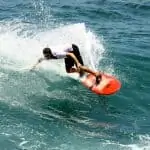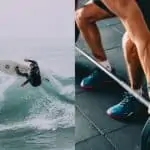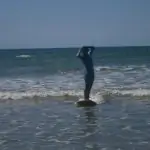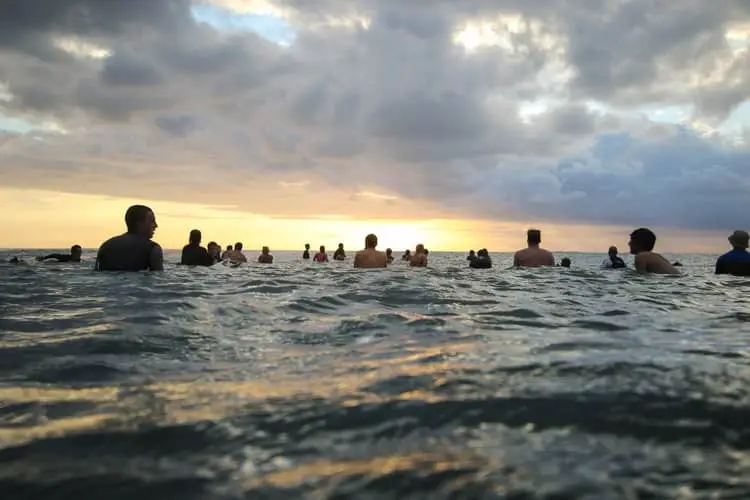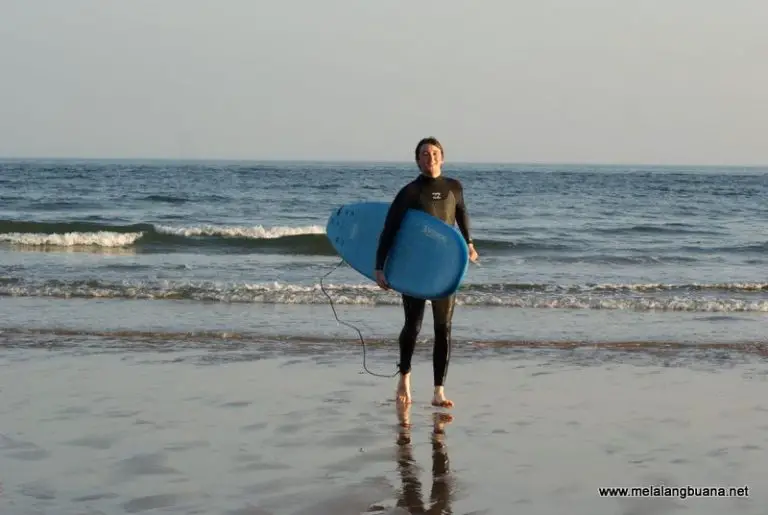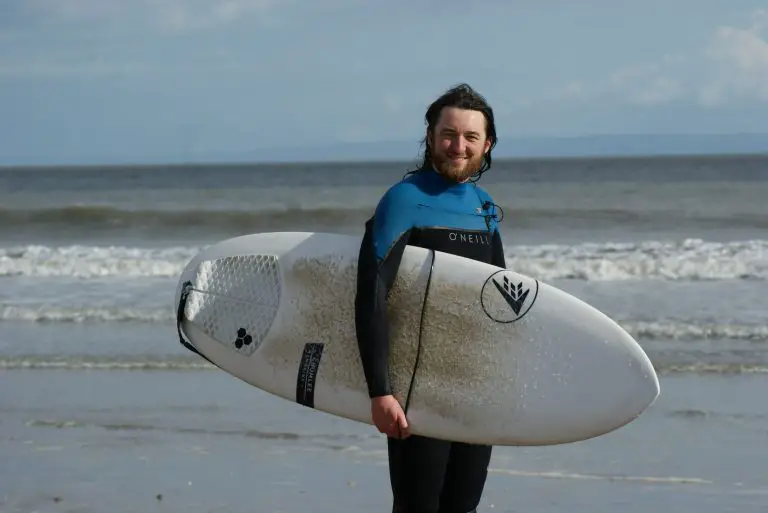10 Tips to Get Better at Surfing Small Waves
When it comes time to hit the beach, not all of us have the option to go at any time or to anywhere we want, and often, this means putting up with small waves at our local spots.
So, to make the most out of the conditions, it’s best to get an idea of how to improve on small waves to maximize the fun you have on any given day.
As such, below are 10 tips on how to get better at surfing small waves!
Keep Your Board Moving
Smaller waves are much less power than bigger waves, meaning speed is harder to generate.
Without speed, you can’t do any maneuvers or turns, which is not much fun!
So, to beat this, keep your board moving all the time you’re riding on small waves. The main way is to tic-tac back and forth, like you would on a skateboard.
This helps to stop your board digging a rail and losing speed, but it will mean more effort for you as you’ll be needing to squeeze out every last drop from each small wave you ride.
Summary
Think like you’re on a skateboard – tic-tac back and forth and keep your board doing all the work, don’t expect the wave to help you!
Go for Extra Volume
Choosing the right board is probably the first step in improving your surfing in small waves. This is because your board dictates what is or isn’t possible when you are out in the surf.
You’ve probably heard the phrase that ‘it’s like taking a gun to a knife fight’, which can definitely be applied to turning up to surf small waves with the wrong surfboard!
To help you get into small waves, you’re going to need a board with more volume than usual.
This is because the added volume gives you more float when you are riding a wave.
The more float, the less drag you have and so the faster you can go.
This also helps massively because your board does more work for you, keeping you higher up on the surface of the water.
Since small waves have much less power, using a board with more volume to pick up some of the slack is absolutely necessary.
Extra volume in a surfboard is also another way to get more speed when riding small waves.
Boards with this kind of volume may be thicker or wider but it’s important to note that going too thick or wide can also make the board hard to turn.
This feeling of a board that is difficult to maneuver for this reason is often called ‘boaty’ since it makes things difficult.
Choose Your Board Carefully
With that in mind, I recommend looking at the volume of the board you use for good quality waves and adding about 10% to it for an ideal small wave surfboard for you.
So, if your good-wave surfboard is 27 liters in volume, go for a board with around 30 liters of volume for weaker or smaller waves.
This added volume will help with paddling and catching waves and shouldn’t be too much of a difference when it comes to trying to do maneuvers, either.
You can also see an old clip of Kelly Slater, the GOAT of Surfing, and originally from small-wave Florida, out in some small waves in California in the clip below. Notice how his board is a little thicker than the usual pro surfers’ boards of the day, and also how smooth he is in the weak waves.
Good Small-wave Shortboard
For me, the Firewire Chumlee is a great small-wave shortboard. This is because it floats extremely well and has the shape to allow for turning, unlike its ‘cousin’ the Sweet Potato, which is just a bit too extreme of a shape for turning well.
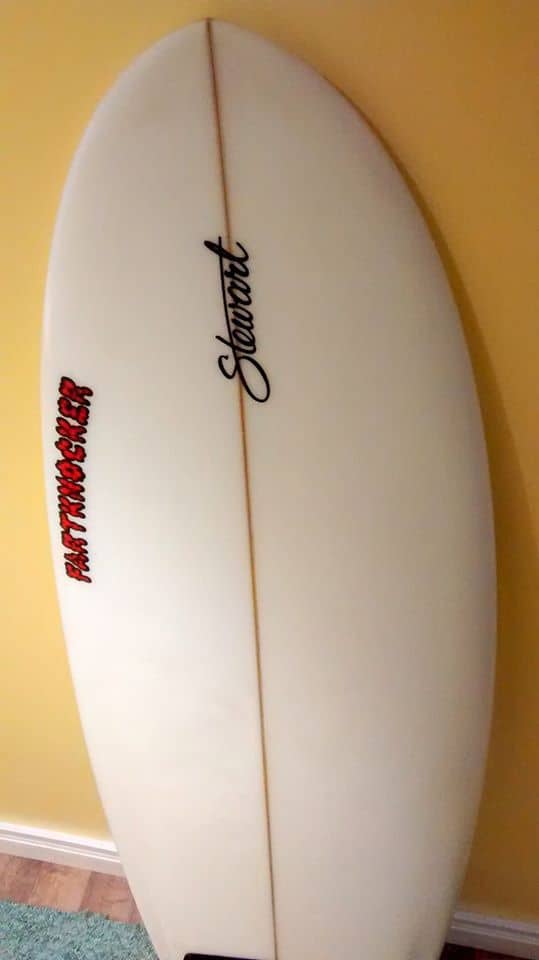
After selling the Fartknocker shown above, I got a Chumlee a few years later and haven’t looked for another small-wave ‘groveler’ board since.
Other good small-wave surfboards include:
- Lost Puddle Jumper
- Lost Bean Bag
- Any of the JS ‘Pony’ series
- FireWire Baked Potato
Summary
Remember: an ideal small-wave surfboard to help you improve will be a bit wider than your usual board but still short enough to turn quickly!
Get Down Low
To be able to turn your surfboard, you’re going to need to maximize every bit of your body’s ability to generate speed and pivot.
To do this, you will need to be able to get down low as you pump down the line. Moving up and down in a fluid motion while bending your knees will help you to get more out of weak waves.
It might feel a little odd at first but you should try to make a conscious effort to get lower than you might think is needed.
Summary
Use your body’s extension to its max. and flow with the wave for as much speed as possible, flowing up and down as you go.
Hit the Surf WARM!
Paddling out into a small-wave lineup, especially on colder days, can make it a real challenge to surf near your best.
This is because you probably won’t have that much paddling to do to get warmed up and you may not have many waves to choose from.
Being cold when surfing small waves makes you less flexible and agile, and also slower through turns and getting to your feet, which are both crucial for surfing small waves well.
To beat this, warm up properly on dry land to get the blood flowing.
Do some dynamic movements ideally for up to 5 minutes, and no, I don’t mean stretching here!
You could run to the shoreline and up and down the beach, or anything else that gets you to break a light sweat before paddling out.
Summary
Having your blood pumping and muscles warmed up will mean you can let rip with the big turns in small waves!
Focus on the Right Moves
Before heading out into tiny waves, you might have been watching some pro surfers tearing up perfect waves somewhere around the globe, doing airs and big turns.
However, you need to keep your focus on the kinds of moves that you can actually do in small waves.
Yes, the pros might be able to do many of the same moves, but remember that smaller waves make it much harder to turn on, so be realistic here.
Big cutbacks and hacks off the top might not be possible, but things like snaps and floaters are still doable. As for airs, it really depends on the type of small waves – if they are punchy and onshore, then you might be able to generate enough speed but you’d be lucky to have such conditions
(Editor’s note – I cannot do airs so feel free to tell me if I’m wrong on this one!)
Summary
Focus on realistic moves like snaps and floaters, perhaps airs if the conditions permit. Don’t try and force out maneuvers that the small surf just won’t lend itself too.
Just Get In There!
This one is definitely easier said than done on a bad-surf day but one of the only tried and tested ways to get better at surfing small waves is to get out there regardless!
[Q]Turning up and the waves looking small can be off-putting, but if it’s a choice between no surf and small surf, to improve, you’ll need to get in every time!
This helps to keep you flowing and moving, as well as keeping those all-important paddling muscles powered up.
It also helps to get a feel for the movements you need to start doing turns and maneuvers in small surf.
The more time you spend on small waves, the more intuitive they will become.
Along with Kelly Slater, world champion CJ Hobgood, his brother Damien Hobgood and many other professional surfers come from Florida, where they would hit the waves at every possible opportunity.
In fact, retired pro surfers Cory Lopez and brother Shea Lopez even grew up on Florida’s Gulf Coast, meaning small surf only a handful of times a year – they got in and made the most of it, and so should you!
Summary
Get in the small waves at every opportunity as you will improve each time you do. Remember that it’s all about having fun, which you can only do when you paddle out!
Fuel Up for Speed and Energy
Fueling up with good food and the right fluids will also give you a boost when it comes to surfing small waves better.
This is because you will need the energy since the waves won’t have much so it means more work for you.
Eat at least an hour before the surf to avoid it ‘repeating’ on you (!), something which I have had a few times and you don’t definitely don’t want it to happen to you!
A combination of light carbohydrates and clean proteins are recommended, with things like smoothies being a great option (Source).
Just remember to avoid the starchy carbs and fried foods as these can make you feel sluggish, sleepy and heavy, which will not help your small-wave surfing ability!
To go with some good food, stay hydrated for maximum flexibility; proper hydration will also reduce things like inflammation, as well as keeping you feeling well day-to-day.
Summary
Eat an hour before a surf with light, clean carbohydrates and proteins and consume lots of water. You want to feel energized but not overloaded to surf in small waves, which you can do by following these rules.
Train Like Crazy Outside of the Surf
Because small waves have a much smaller ‘playing field’, you will need to be ‘zippier’ and more agile than on bigger waves to surf them well.
This means that training outside of the surf will give you a huge boost as it can be the difference between completing a turn on a small wave and simply bogging your rail and falling flat on your face.
To help with the above, practise doing ‘explosive’ pop-ups at home every day. This will help you to speed things up on a board and also keep you in good shape.
You can look at different ways to help you perform your pop-ups faster, as well as to do them more efficiently without losing your balance.
The take-off is crucial for small-wave speed so the better you can get at it, the better you can surf small waves! Each millisecond counts in small waves, so remember that!
Summary
Practise pop-ups every day at home, look at ways to increase your agility while also making your surf movements more explosive ready for when it comes time to hit the waves.
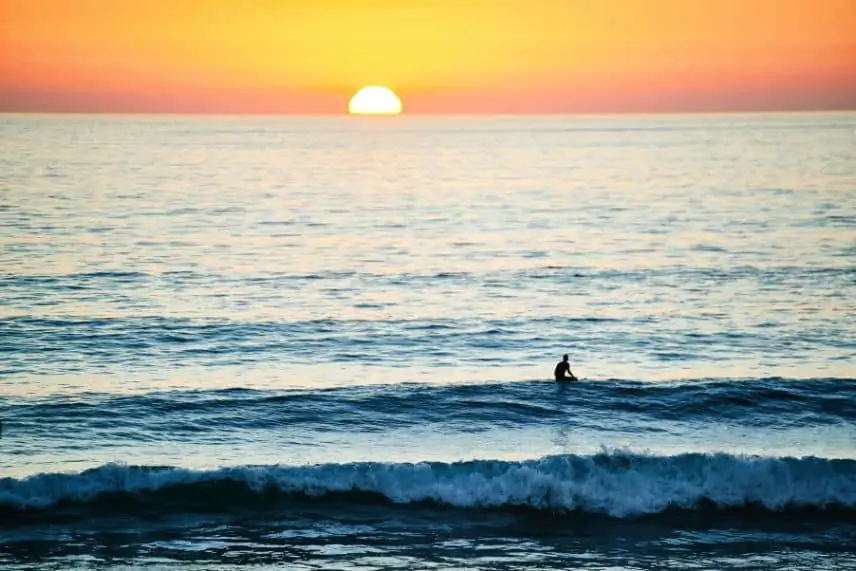
Photo Credit: Valentino Funghi on Unsplash
Fine-tune Your Take-off
To add to the points above, your take-off is absolutely crucial in small-wave surfing.
This is because it can mean the difference between getting some fun out of a ride and just a pump or two before a closeout.
Think about planting your feet properly from the off, as well as looking exactly where you want to go and having your arms perfectly positioned right from the get-go.
If you can master this, you will notice the extra hundredths of a second making a difference in your tiny-wave surf game and get just that extra few percent out of each ride.
Summary
Hone your take-off technique so that your feet and arms are in the perfect position from the off, and look to where you want to go at all times.
Focus on Sprint Training
This is something that was lost on me for years but, if you think about the patterns of surfing, it involves periods of inactivity followed by intense bursts of speed for paddling, taking off, riding and then paddling back out.
With this in mind, you can focus on sprint training to help you get more explosive when it comes to surfing, meaning you can blast off on small waves when they roll through.
In fact, when out in the lineup for small waves, you will go from sitting still for a long time to an intense few seconds of effort to ride a wave.
To train for small waves, try the following training options:
- Sprint burst interval training
- Any bodyweight HIIT routines
- ‘Boxercise’ or other intense martial arts workouts
There are lots of good options for these online but Kris Mills the Surf Strength Coach has some fantastic free training program options on his website – be sure to have a look!.
As well as the above, watching clips of pro surfers in small waves shows them staying extremely nimble and light on their board, which you want to try to emulate and is a great guide.
As always, the guys from How to Rip also have a few great videos on this topic, as you can see below:
Summary
Think about training for intense bursts of activity with programs like HIIT, interval training. You also want to avoid training by doing things like long, slow runs, etc. – surfing is all about speed and bursts, so make sure your training matches this!
